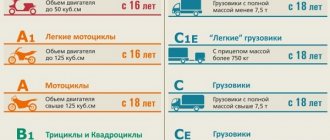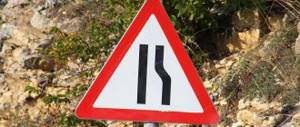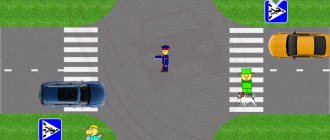Who is a pedestrian?
A pedestrian is a road user who, when moving, does not drive a vehicle or perform work on it. Pedestrians include disabled people in wheelchairs without a mechanical motor, owners of bicycles or mopeds who move them along the road.
In a word, a pedestrian is a person who walks on the roadway. According to the law, he is allowed to move on pedestrian paths, sidewalks or on the side of the road towards vehicle traffic if the first two options are not available.
Driver and pedestrian
In the rules of the road, a driver is any person who drives or teaches how to drive a vehicle. A pedestrian, in turn, is a person who is on the road, that is, outside the vehicle. Of course, road repair workers are not pedestrians. But they are considered people in wheelchairs (not equipped with motors). If a driver drives a bicycle or motorcycle along the side of the road, he is also a pedestrian.
The difference between the definitions of “operating a vehicle” and “driving a vehicle,” as you can see, is quite large. If a person rides a bicycle, he is subject to the rules as a driver. And from the moment he leaves the bicycle saddle and walks, driving his vehicle in his hands, he will be subject to the responsibilities of a pedestrian.
However, both the driver and the pedestrian are full participants in the road traffic.
How to cross the road correctly?
To cross the roadway there are ground, underground and overpasses. These are the safest methods for humans. By the way, bicycle owners must cross the road on foot. But unfortunately, crossings are not available everywhere; if they are absent, a pedestrian road user can cross the roadway at an intersection along the sidewalk lines or the side of the road.
If all of the above conditions are absent, then you can cross the roadway at a right angle in an area where there are no fences or an approaching vehicle. But you need to remember about your own safety; in the dark or in poor visibility conditions, it is advisable to have reflective elements on your clothes. Despite the fact that this is a rule, there are no penalties for violation of it by law.
At a pedestrian crossing, it is also important to take care of your own safety. Before crossing the road, you need to make sure that the traffic will be safe and that there is no approaching vehicle. Because, despite the fact that the driver is obliged to let the pedestrian pass, he may not have time to brake.
Who is a pedestrian and where should he move?
The definition prescribed in the Traffic Rules states that a pedestrian is a person who is outside the vehicle on the road (not working on it). People in wheelchairs without a motor are also considered pedestrians. In addition, if a person is driving a bicycle, moped or motorcycle on the road, he is also considered a pedestrian.
At night, it is better for a pedestrian to have reflective elements on his clothes, but the law does not provide for any punishment for their absence
According to traffic regulations, a pedestrian must move along the sidewalk or a special pedestrian path, or, if there are none, along the side of the road. In some cases (if a pedestrian is carrying/carrying a bulky object or is moving in a wheelchair, interfering with the movement of other people), pedestrians can move along the edge of the roadway. If the road has neither a sidewalk, nor a pedestrian path, nor even a shoulder, driving along the bicycle path (if it exists) or along the outer edge of the road in one row is allowed. Being in the middle of the road or near the median strip is not only against the Rules of the Road, but also dangerous to life.
Pedestrian crossing (zebra crossing)
In this case, people walking should follow against the flow of traffic, and pedestrians in wheelchairs or driving a motorcycle/moped/bicycle should follow in the same direction as the flow of traffic. If movement occurs in the dark or in conditions of insufficient visibility (rain, fog, snowfall), the pedestrian is recommended to have reflective elements on his clothing. However, this is not a mandatory condition, so there are no penalties for the absence of such elements.
Pedestrian rights
Since a pedestrian is a person who in one way or another participates in road traffic, he has his own rights defined by law. Firstly, he may be a participant in an accident, both the culprit and the victim. Here the pedestrian has the right to disagree with the charges brought against him by traffic police officers, to express his opinion and not to sign the protocol. Secondly, the legislation provides for rules for the movement of a pedestrian road user in different conditions.
But in practice, it turns out that drivers driving a source of increased danger have greater priority on the road. A pedestrian is a more vulnerable traffic participant and he is forced to take care of his safety on his own.
Pedestrian movement
To ensure the safety of pedestrians, roads are equipped with specially designated areas, such as sidewalks or pedestrian paths. On roads without sidewalks, pedestrians are allowed to walk along the side of the road.
Also, if there is no sidewalk, the pedestrian is allowed to walk on the bike path. Only people in wheelchairs or those carrying bulky loads may move along the edge of the roadway.
Pedestrians are prohibited from moving in the middle of the road, as well as next to the median strip . This is not only regarded as a violation of traffic rules, but poses a great danger to the health and life of the person himself.
A person walking on the side of the road must move in the direction opposite to the movement of cars . But when a pedestrian is holding another vehicle, such as a scooter or motorcycle, he must move in the same direction as the drivers.
When moving along the sidewalk, a pedestrian must stay on the right side, that is, move in the direction of vehicle traffic.
Fines for pedestrians
For violations of traffic rules, a pedestrian is brought to administrative responsibility. Here is the list of fines:
- When crossing the road at a red traffic light, regardless of whether there are approaching cars or not, the fine is 500 rubles.
- When crossing the roadway near a pedestrian crossing. Even if there are no barriers, excellent visibility and doing it at a right angle, you can get a fine of 500 rubles.
- According to traffic rules, you should go around the bus from behind, and the tram in front. Failure to comply will result in a fine of 500 rubles.
- If the zone into which a person has entered is marked with a “no movement” sign, he is issued a fine of 500 rubles.
- Each participant is obliged to give way to a vehicle with a beacon and special lights on. signal. If a pedestrian violates this rule, the fine for him will be 500 rubles.
- You can wait for a taxi and land on the roadway only on a specially designated lane or side of the road. For violation, a fine of 500 rubles.
- In the absence of a sidewalk or shoulder, a pedestrian can move along the edge of the roadway towards the movement of cars. In case of violation, the fine is 500 rubles.
Ignorance of the laws does not exempt citizens from responsibility, so the absence of a personal vehicle is not yet an indicator that it is not necessary to know the rules of behavior on the road.
Driving on sidewalks
Until now, personal electric vehicles are not mentioned in the traffic regulations, so scooter riders must obey the rules for ordinary pedestrians. This applies to skates and the mobility aids mentioned above. It is prohibited for them to enter the roadway. If interference or risks to the health of other pedestrians are created, then such traffic participants can move from the edge of the roadway.
How to protect yourself on the road?
Often, a pedestrian is the culprit of a traffic accident. If the damage to the car itself may be insignificant, then a pedestrian participant can say goodbye to his health or life. Therefore, despite the fact that he has his certain rights on the road, he must first take care of his safety.
First you need to learn and understand all the rules of the road. And put them into practice. In any situation, you must not let your guard down, because pedestrians suffer first, and mostly through their own fault.
If a pedestrian is a traffic participant, then he has his own rights and responsibilities along with drivers. The legislation of our country regulates all requirements and every citizen is obliged to clearly know them, first of all, in order to protect himself.
Location of pedestrians on the road
Now let's discuss the rules related to the movement of pedestrians on the road :
4.1. Pedestrians must move on sidewalks, pedestrian paths, bicycle and pedestrian paths, and, if there are none, along the roadsides.
If there are no sidewalks, pedestrian paths, bicycle paths or shoulders, and also if it is impossible to move along them, pedestrians can move along a bicycle path or walk in one row along the edge of the roadway (on roads with a dividing strip - along the outer edge of the roadway).
So, the pedestrian must choose to move (in descending order):
- Sidewalk, pedestrian path, bicycle and pedestrian path.
- Roadside.
- A bicycle path or the edge of a roadway.
The figures below indicate all the elements of the road along which pedestrian traffic is possible:
Let's look at what each of the terms listed above means.
Sidewalk
“Sidewalk” is an element of the road intended for pedestrian traffic and adjacent to the roadway or bicycle path or separated from them by a lawn.
Roadside
“Shoulder” is an element of the road adjacent directly to the roadway at the same level with it, differing in the type of surface or marked out using markings 1.2.1 or 1.2.2, used for driving, stopping and parking in accordance with the Rules.
At the same time, there cannot be both a sidewalk and a curb . The sidewalk is either adjacent to the roadway or separated from it by a lawn. The shoulder also adjoins the road at the same level as it. Those. the shoulder must be located at the same level as the road.
For example, if a depression (ditch) begins on the side of the roadway, then there is no shoulder on such a road.
Footpath
“Pedestrian path” is a strip of land equipped or adapted for pedestrian traffic or the surface of an artificial structure, marked with sign 4.5.1.
The pedestrian path is indicated by sign 4.5.1:
Bike and pedestrian path
“Pedestrian and bicycle path (pedestrian and bicycle path)” is a road element (or a separate road) structurally separated from the roadway, intended for the separate or joint movement of cyclists with pedestrians and indicated by signs 4.5.2 - 4.5.7.
The bicycle and pedestrian path is indicated by signs 4.5.2 - 4.5.7:
First of all, the rules require pedestrians to choose to travel either on the sidewalk, on a pedestrian path, or on a bicycle and pedestrian path.
But what to choose if you have all the listed elements at the same time? In this case, you can choose the road at your own discretion.
If there is no pedestrian path, no bicycle path, no sidewalk on the road, then traffic rules allow you to walk on the side of the road. If there is not even a shoulder, or it is impossible to move along it, then you can continue driving along the roadway or bicycle path.
Pedestrians in wheelchairs and carrying loads
Pedestrians carrying or carrying bulky objects, as well as persons using non-motorized wheelchairs, may walk along the edge of the roadway if their movement on sidewalks or shoulders creates an obstacle for other pedestrians.
Please note that the rules allow a special mode of movement for persons carrying bulky items, as well as those in wheelchairs. They can, on their own initiative, choose the roadway instead of driving on the sidewalk.
However, this is a right, not an obligation. Those. Even if a bulky object interferes with other pedestrians, you are not required to go out onto the roadway with it.









